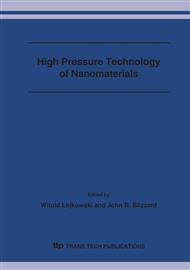p.183
p.189
p.199
p.211
p.219
p.227
p.233
p.239
p.245
Fabrication and Micro-Structure Characterization of Al2O3/Ni-P Composites with Interpenetrating Phases
Abstract:
The fabrication of 3D interpenetrating phases in ceramic-metal composites by high pressure sintering of ceramic powder coated with Ni-P nanoparticles produced by electro-less chemical plating is reported. Electro-less nickel plating resulted in a nano-metric layer of spherical Ni-P nanoparticles of approximately 20-50 nm diameter over the entire surface of the ceramic powder. The coated powders were consolidated by hot pressing (HP) process followed by pressureless sintering after cold isostatic pressing (CIP). SEM, TEM and XRD methods were used to investigate the influence of the consolidation temperature and pressure on the microstructure of composites and particularly the morphology of metallic Ni-P phase. The homogeneity of the interpenetrating network structure was measured by computer image analysis and compared with the results of electric resistance measurements. The results indicate that the use of electroless nickel plating and high pressure consolidation process enables the fabrication of uniform 3D interpenetrating continuous metal-ceramic composites and controlled-density composites possessing a metallic phase of nano- or micro-metre size.
Info:
Periodical:
Pages:
219-226
Citation:
Online since:
July 2006
Price:
Сopyright:
© 2006 Trans Tech Publications Ltd. All Rights Reserved
Share:
Citation:


